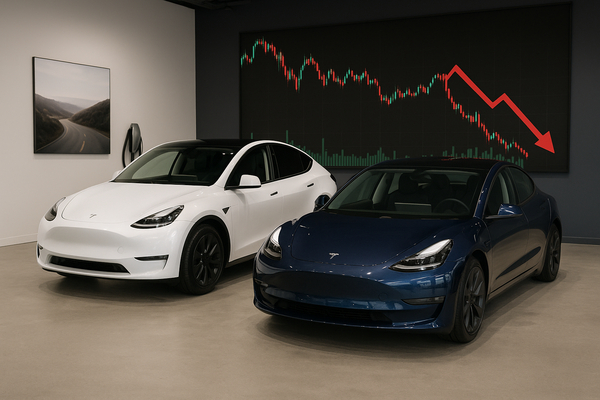
Tesla’s new lower-priced Model Y and Model 3 have landed in markets and markets have shown an immediate reaction. The Model Y Standard lists at $39,990 and the Model 3 Standard at $36,990. Shares of Tesla (NASDAQ:TSLA) moved intraday, ending a recent session down about 4.4% at $433 as investors absorbed pricing, delivery and margin implications. Short-term, the launches aim to arrest slowing deliveries. Longer-term, they reframe pricing power and competitive intensity across electric vehicles globally, including the U.S., Europe and China.
Tesla pricing, deliveries and market reaction
Tesla’s rollout of the Model Y Standard ($39,990) and Model 3 Standard ($36,990) is a clear tactical push to expand addressable demand. The stock (NASDAQ:TSLA) has been volatile: one report shows shares closing down 4.4% at $433 after the announcement, while other intraday prints ranged from $441 to the mid-$450s in the lead-up to the reveal. Consensus analyst context is mixed — the firmwide consensus price target recently moved from about $331.58 up toward $350.50, reflecting an upward revision in some expectations even as headline volatility rose.
Operationally, Tesla reported stronger-than-expected deliveries in Q3 that underpinned part of the recent analyst optimism. Yet cheaper trims compress gross margins on the core vehicle business. Given Tesla’s stated goal to scale volumes dramatically over the next decade, lower-priced SKUs change the revenue-per-vehicle math. Investors reacted quickly: the stock swung roughly 3–5% on the news across sessions, an indication that traders are grading both demand elasticity in real time and the program’s margin trade-off.
Amazon’s retail and logistics moves are reshaping e-commerce economics
Amazon (NASDAQ:AMZN) remains a structural force in consumer discretionary demand. Goldman Sachs lifted its price objective to $275 from $240 and kept a Buy rating, highlighting AWS strength and new product ecosystems as upside drivers. On the ground, Amazon paid $97.6 million for a large Ocala, Florida warehouse to expand U.S. distribution capacity — a concrete capital outlay that supports faster delivery and seasonal inventory handling.
Amazon’s buy-and-build cadence matters now because it intersects with broader retail flows. Analysts cited by outlets gave Amazon a “Perfect 10” on AI and cloud momentum, while the firm’s marketplace and logistics investments increase gatekeeper power for third-party sellers. Short-term, the warehouse purchase tightens fulfillment throughput ahead of holiday selling; long-term, continued capex at that scale supports higher fixed-cost absorption for Amazon’s two-sided retail-advertising model.
Auto sector strains: Ford’s supply hit and EV incentive shifts
Traditional automakers are feeling immediate pressure. Ford Motor Company (NYSE:F) shares fell after supply concerns tied to a major aluminum-plate fire; the stock was quoted at $11.92, down 6.14% in one session. The broader context: the $7,500 U.S. EV tax credit that had supported demand recently expired, and proposed tariff changes on imported medium- and heavy-duty trucks add further cost uncertainty for fleet buyers and OEM sourcing. Together these developments are weighing on production outlooks for both ICE and EV lines.
Smaller EV peers also showed swings. Lucid Group (NASDAQ:LCID) highlighted delivery dynamics: one report cited a one-month share rally of nearly 20% before a pullback, and a session print at $22.01 marked an 8.37% decline on a day of weakness. Rivian (RIVN) and others continue to trade on execution news as investors reassess manufacturing tightness versus demand. The combination of supply interruptions and incentive shifts is producing volatile 1–4 week moves across auto names and their suppliers.
Retail and travel: staffing, restructuring and rolling earnings risk
Consumer-facing services are showing divergent signals. Airbnb (NASDAQ:ABNB) announced a stepped-up push into hotels with global job listings; the strategy will be labor-intensive and is described as a multi-year build. That hiring cadence matters now because it signals an investment cycle that can pressure near-term margins while potentially expanding lodging inventory exposure globally.
Travel platforms have already felt swings: Booking Holdings (NASDAQ:BKNG) closed at about $5 in one session, down 3.28% from the prior trading day. On the restaurant and coffee front, Starbucks (NASDAQ:SBUX) is executing a $1 billion restructuring and closed three Spokane locations; the stock fell roughly 5% to $82.11 on news of workforce reductions and leadership change. These moves feed into market sentiment for discretionary spending: higher structural costs and one-off restructuring charges can tighten earnings-per-share in quarters ahead.
What the data tells investors about risk appetite and positioning
Quantitative flows show rotation rather than a single-direction move. AI and cloud names have absorbed fresh capital, while some consumer discretionary names face inventory, supply and macro risks. Amazon’s $97.6 million logistics purchase and Goldman’s $275 price objective underline investor confidence in scale assets and AWS margins. Meanwhile, Tesla’s stock moved down into the low-$400s after its pricing announcement even as its longer-term consensus target ticked up to the mid-$300s range — a sign that headline announcements prompt re-ratings of both growth and profitability expectations.
Short-term relevance centers on holiday-season capacity and the next quarter’s earnings windows: Auto OEMs and suppliers are trading on delivery and supply headlines now; retailers and hospitality chains face margin and labor news that will appear in upcoming releases. Longer-term relevance rests with structural choices: pricing strategies at Tesla, Amazon’s logistics capex, and hotel expansion at Airbnb will change market share and fixed-cost leverage across geographies from the U.S. to Europe and Asia.
Data points cited in this commentary are drawn from recent company disclosures and contemporaneous market prices: Tesla’s Model Y Standard ($39,990) and Model 3 Standard ($36,990); Tesla share prints near $433 after a session decline of about 4.4%; Amazon’s Goldman Sachs price objective of $275 and a $97.6 million Ocala warehouse purchase; Ford’s session close near $11.92 (down ~6.14%); Booking Holdings’ session close around $5 (down 3.28%); Starbucks at about $82.11 following a near-5% drop. This set of figures illustrates how discrete operational decisions translate into measurable market moves across consumer discretionary subsectors.
No investment advice is offered; this commentary is informational and compiles public-market data and company announcements to explain current market dynamics within the consumer discretionary sector.












